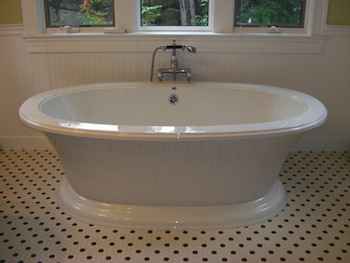By Tim Carter

DEAR TIM: I just bought a home with a large bathroom that's perfectly suited for a vintage tub. Are the plumbing requirements any different for these fixtures, as opposed to standard built-in tubs and showers? If you were installing a vintage tub and bath at your home, what would you do to make sure there were no problems from water that might splash out of the tub? --Rochelle D., Washington D.C.
DEAR ROCHELLE: I never understood the attraction of a vintage bathtub until I sat in a clawfoot relic that we were about to remove from an old home. It was after lunch, and the mammoth vessel was so comfortable I almost fell asleep in it. Whoever designed it made sure the slope of the tub back and height of the side walls perfectly fit the average body. Total relaxation set in within seconds after I sat in the tub and put my arms up on the rim.
If you decide to install one of these magnificent plumbing fixtures, I've got good news. There are no extraordinary plumbing requirements for the tub. The biggest things you have to take into consideration are the rough-in locations for the gorgeous exposed drain piping and the decorative water supply lines. These need to be precisely positioned so they are plumb and centered with the tub. A good plumber can do this with little effort.
A bigger concern, in my opinion, is the subfloor framing. A vintage tub produces concentrated loads at the four locations where the feet touch the floor. A standard built-in tub that's properly supported usually transfers its weight to the side wall and along the entire edge of the tub skirt. Some built-in tubs have a rigid foam pad under them that helps distribute the load over the entire floor beneath the tub.
I would install vertical blocking directly under the location of each foot of the vintage tub you're installing. This blocking consists of a short piece of floor joist that's nailed between two other full-length floor joists. This blocking prevents the subfloor sheathing from sagging under the weight of the tub when it's loaded with water and a bather.
Water can splash out of these tubs if kids are in them or if you have a pseudo-vintage pedestal bathtub like mine. My tub has a built-in whirlpool feature. When the bubbler is on high, it does splash water out of the tub.
Many people think that a tile floor is waterproof. Most tile is waterproof, but the grout lines between each tile are not. Water can seep through a grout joint and over time cause wood rot under a tub.
You can treat regular wood with a borate solution that is safe for humans but that is toxic to most fungi that cause wood rot. You may want to spray the floor joists several times with this solution, as well as to saturate the subfloor sheathing on both the top and underside. When the borate solution dries, it does a great job of protecting regular lumber.
You can also install 30-pound felt paper on top of the subfloor before the cement-based tile underlayment is installed. I'd overlap the felt seams no less than 9 inches. This felt can extend over the entire subfloor of the bathroom and turn up several inches where it touches the walls. It's a great line of defense for any water that saturates the cement underlayment.
Be sure the water supply lines that feed the tub faucet are at least 3/4 inch in diameter. Vintage tub faucets often are designed to allow for a heavy flow of water so the tub fills quickly. If you have 1/2-inch supply lines and normal water pressure, the tub can take a considerable amount of time to fill.
As crazy as this sounds, make sure the door into the bathroom is wide enough to allow you to bring in the tub to the room after the finished floor is installed and the room is basically finished.
Built-in tubs are installed during rough construction when doors and doorframes are just a gleam in the eye of the finish carpenter. Vintage tubs are installed at the end of the job after the bathroom is completely finished. Believe me when I tell you that more than one bathroom doorway has had to be altered to get a vintage bathtub into a room!
Consider installing a remote bathroom exhaust fan in this new bathroom. These are very quiet and will allow you to vegetate in the tub without the pesky drone of a standard bathroom exhaust fan. Remote fans gently vacuum all of the water vapor produced by the steaming bath out of the room and through the roof of your home. Place the fan inlet over the tub. Many come with an accessory light to illuminate the tub. You can connect two inlets to the same fan allowing you to fully ventilate the bathroom.
© Tim Carter, Ask the Builder
AUTOS | HOBBIES | EDUCATION | FAMILY | FASHION | FOOD & RECIPES | HOME DECOR | RELATIONSHIPS | PARENTING | PETS | TRAVEL | WOMEN
Home & Garden - Installing a Vintage Bathtub